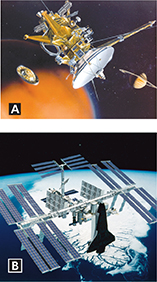Over the next few years, five more moon landings took place. Astronauts performed many scientific experiments and brought back to Earth 382 kilograms of rock and soil samples. The last lunar mission, Apollo 17, was completed in 1972.
Recent Space Missions
Although humans have not yet travelled across the solar system, scientists have gathered much new information about various planets and moons. In the decades since the Apollo program, nearly all of the planets and moons of the solar system have been photographed by space probes. A space probe is an unpiloted vehicle that carries scientific instruments into space and transmits information back to Earth. In 2004, NASA successfully landed two space probes, named Spirit and Opportunity, on Mars. Later that year, the space probe Cassini, shown in Figure 4, began exploring the Saturn system of rings and moons from orbit.
The Hubble Space Telescope, launched into orbit around Earth in 1990, has also provided many new views of the solar system and beyond. Today, scientists rely mainly on space probes and telescopes to gather new information about the solar system.
Recent human space flight has centered on the near-Earth missions of the space shuttle. The shuttle is a reusable space vehicle that is launched like a rocket but lands like an airplane. Today, a new era of cooperation exists in the exploration of space. An important step has been the development of the International Space Station, shown in Figure 4. The space station is a permanent laboratory designed for research in space. Astronauts from various countries are currently living aboard the partially completed structure, which is scheduled to be finished in 2010.
Figure 4 Modern technology is used to send spacecraft into orbit and to explore the planets. A The space probe Cassini launches a probe to explore Saturn's largest moon, Titan, in this illustration. B A space shuttle is docked to the International Space Station in this computer-generated illustration.

Section 25.1 Assessment
Reviewing Concepts
 What is the difference between the geocentric and heliocentric models of the solar system?
What is the difference between the geocentric and heliocentric models of the solar system? Why don't planets travel in straight lines?
Why don't planets travel in straight lines? What are the four types of bodies in the solar system?
What are the four types of bodies in the solar system? What are some ways that scientists are currently learning more about the solar system?
What are some ways that scientists are currently learning more about the solar system?
Critical Thinking
Comparing and Contrasting How has the focus of the U.S. space program changed since the time of the Apollo program?
Applying Concepts Why do some stars seem to rotate around Polaris at night?
Math Practice
Using Figure 3, find the average distance of Mars from the sun, in km.
Orbiting 2.77 AU from the sun, Ceres is the largest of a group of objects called asteroids. How far from the sun is Ceres in km? Between the orbits of which two planets does the orbit of Ceres lie?




